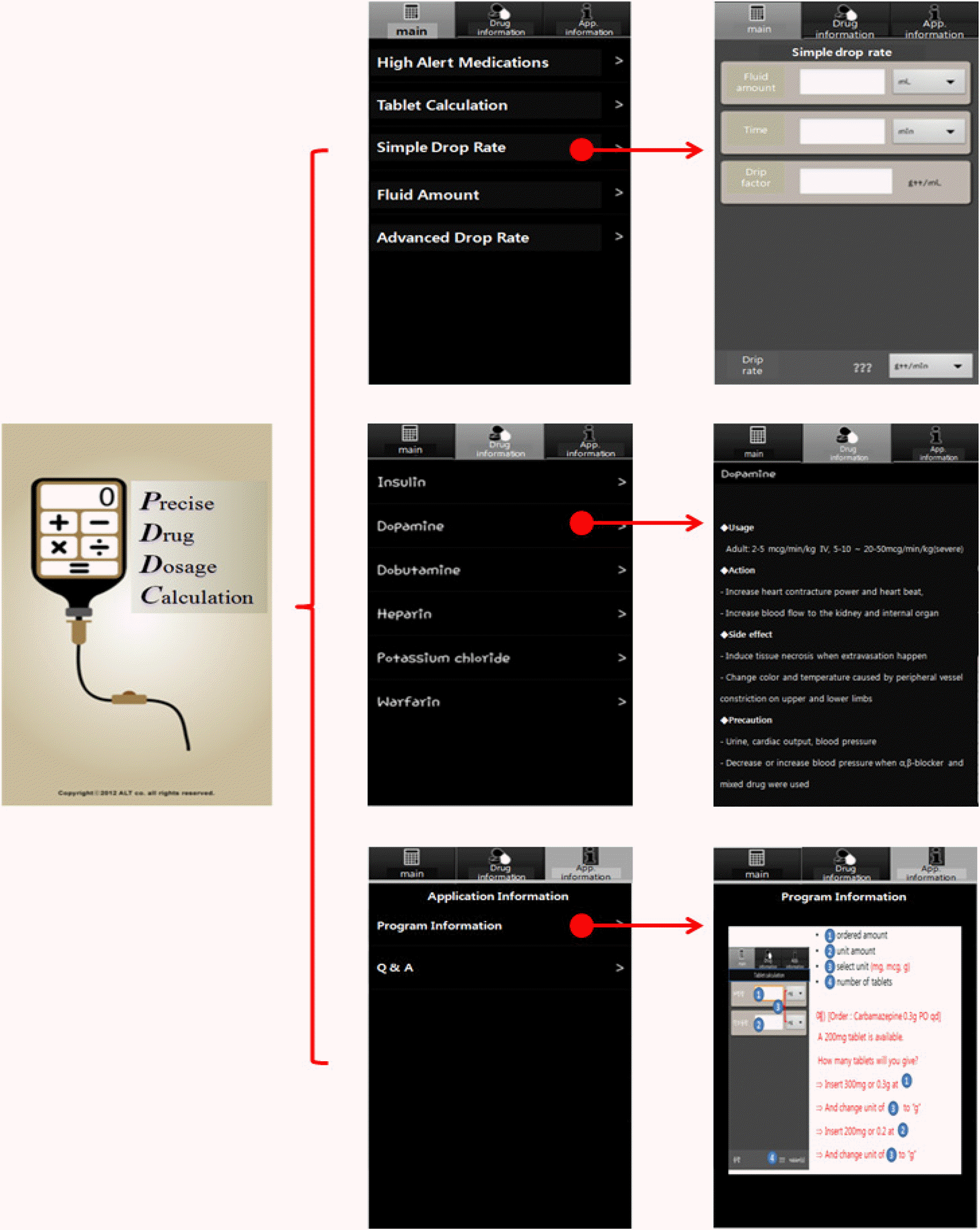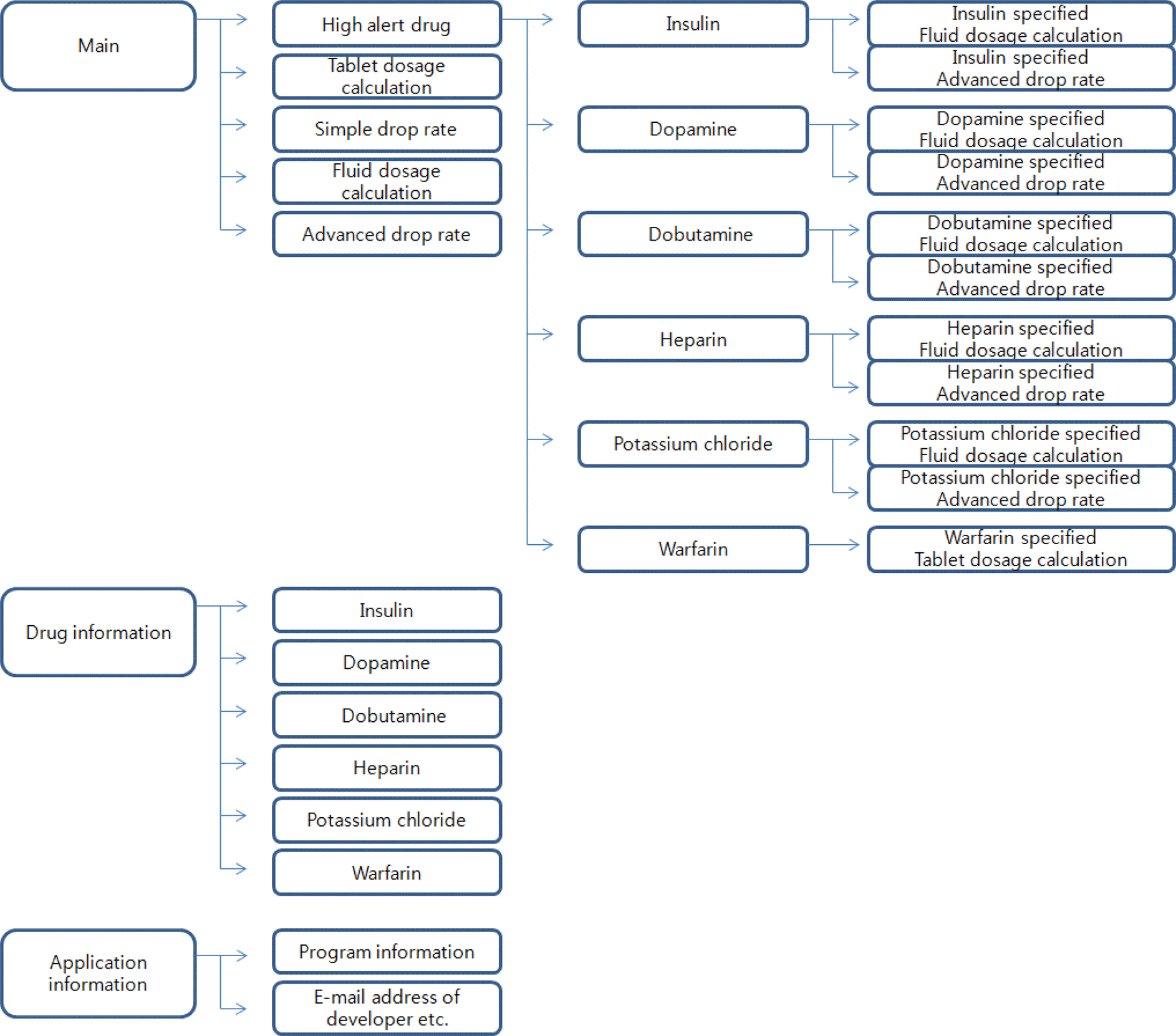Abstract
Purpose
This study was done to develop and evaluate a smartphone application for the medication confirmation of high-alert medications.
Methods
A nonequivalent control group non-synchronized design was used for this study. Participants in the treatment group used the application for four weeks. Data were analyzed using descriptive analysisx2-test and t-test for the homogeneity of participants and a paired t-test for effectiveness in each group with the SPSS 18.0.
Results
Stability of medication administration was estimated by knowledge and certainty ranged from a score of one to three. A correct answer with high certainty was coded as high stability low certainty regardless of correct answer was coded as a moderate stability and incorrect answers with high certainty were rated as low stability. There were no differences in ‘ knowledge of high alert medication “Certainty of knowledge” stability of medication administration “confidence of single checking medication” and “medication safety activities” between the treatment group and the comparison group. The treatment group reported a greater difference between pretest and post-test in ‘ certainty of medication knowledge’ (t=3.51p=.001) than the comparison group.
Go to : 
REFERENCES
Kim M. S.2012. Medication error management climate and perception for system use according to construction of medication error prevention system. Journal of Korean Academy of Nursing. 42(4):568––578. http://dx.doi.org/10.4040/jkan.2012.42.4.568.

Kim M. S.., Park J. H.., Park K. Y.2012. Development and effectiveness of a drug dosage calculation training program.
Brady A. M.., Malone A. M.., Fleming S.2009. A literature review of the individual and systems factors that contribute to medication errors in nursing practice. Journal of Nursing Management. 17(6):679––697. http://dx.doi.org/10.1111/j.1365-2834.2009.00995.x.

Bruttomesso D.., Costa S.., Dal Pos M.., Crazzolara D.., Realdi G.., Tiengo A., et al. 2006. Educating diabetic patients about insulin use: Changes over time in certainty and correctness of knowledge. Diabetes and Metabolism. 32(3):256––261.

Cho Y.2012. A study on perception and performance for patient safety management in intensive care unit nurses. Unpublished master's thesis, Ajou University, Suwon.
Cohen H.2007. Protecting patients from harm: Reduce the risks of high-alert drugs. Nursing. 37(9):49––55. http://dx.doi.org/10.1097/01.NURSE.0000287726.78164.af.
De Vries A. E.., van der Wal M. H.., Nieuwenhuis M. M.., de Jong R. M.., van Dijk R. B.., Jaarsma T., et al. 2013. Perceived barriers of heart failure nurses and cardiologists in using clinical decision support systems in the treatment of heart failure patients. BMC Medical Informatics and Decision Making. 13:54––62. http://dx.doi.org/10.1186/1472-6947-13-54.

Franke H. A.., Woods D. M.., Holl J. L.2009. High-alert medications in the pediatric intensive care unit. Pediatric Critical Care Medicine. 10(1):85––90. http://dx.doi.org/10.1097/PCC.0b013e3181936ff8.

Grandell-Niemi H.., Hupli M.., Puukka P.., Leino-Kilpi H.2006. Finnish nurses' and nursing students' mathematical skills. Nurse Education Today. 26(2):151––161. http://dx.doi.org/10.1016/j.nedt.2005.08.007.

Hodgkinson B.., Koch S.., Nay R.., Nichols K.2006. Strategies to reduce medication errors with reference to older adults. International Journal of Evidence-Based Healthcare. 4(1):2––41. http://dx.doi.org/10.1111/j.1479-6988.2006.00029.x.

Hsaio G. Y.., Chen I. J.., Yu S.., Wei I. L.., Fang Y. Y.., Tang F. I.2010. Nurses' knowledge of high-alert medications: Instrument development and validation. Journal of Advanced Nursing. 66(1):177––190. http://dx.doi.org/10.1111/j.1365-2648.2009.05164.x.

Jarman H.., Jacobs E.., Zielinski V.2002. Medication study supports registered nurses' competence for single checking. International. Journal of Nursing Practice. 8(6):330––335.
Kane-Gill S. L.., Jacobi J.., Rothschild J. M.2010. Adverse drug events in intensive care units: Risk factors, impact, and the role of team care. Critical Care Medicine. 38(6 Suppl):S83––89. http://dx.doi.org/10.1097/CCM.0b013e3181dd8364.

Keers R. N.., Williams S. D.., Cooke J.., Ashcroft D. M.2013. Prevalence and nature of medication administration errors in health care settings: A systematic review of direct observational evidence. The Annals of Pharmacotherapy. 47(2):237––256.

Kim M. S.2012. Medication error management climate and perception for system use according to construction of medication error prevention system. Journal of Korean Academy of Nursing. 42(4):568––578. http://dx.doi.org/10.4040/jkan.2012.42.4.568.

Kim M. S.., Park J. H.., Park K. Y.2012. Development and effectiveness of a drug dosage calculation training program using cognitive loading theory based on smartphone application. Journal of Korean Academy of Nursing. 42(5):689––698. http://dx.doi.org/10.4040/jkan.2012.42.5.689.

Korea Health Industry Development Institute. 2010. 2007' Korea Institute for Healthcare Accreditation. Sejong: Ministry of Health and Welfare.
Lee J. H.2012. Effectiveness of clinical decision support system for high-alert medications on prevention of medication errors. Unpublished doctoral dissertation, University of Ulsan, Ulsan.
Low D.., Clark N.., Soar J.., Padkin A.., Stoneham A.., Perkins G. D., et al. 2011. A randomized control trial to determine if use of the iResus (c) application on a smart phone improves the performance of an advanced life support provider in a simulated medical emergency. Anaesthesia. 66(4):255––262. http://dx.doi.org/10.1111/j.1365-2044.2011.06649.x.
Lu M. C.., Yu S.., Chen I. J.., Wang K. W.., Wu H. F.., Tang F. I.2013. Nurses' knowledge of high-alert medications: A randomized controlled trial. Nurse Education Today. 33(1):24––30. http://dx.doi.org/10.1016/j.nedt.2011.11.018.

Markowitz E.., Bernstam E. V.., Herskovic J.., Zhang J.., Shnei-derman B.., Plaisant C., et al. 2011. Medication reconciliation: Work domain ontology, prototype development, and a predictive model.AMIA, Annual Symposium Proceedings. 878-887.
Nguyen T. D.., Attkisson C. C.., Stegner B. L.1983. Assessment of patient satisfaction: Development and refinement of a service evaluation questionnaire. Evaluation and Program Planning. 6:299––313. http://dx.doi.org/10.1016/0149-7189(83)90010-1.

O'Connell B.., Crawford S.., Tull A.., Gaskin C. J.2007. Nurses' attitudes to single checking medications: Before and after its use. International Journal of Nursing Practice. 13(6):377––382. http://dx.doi.org/10.1111/j.1440-172X.2007.00653.x.
Pham J. C.., Andrawis M.., Shore A. D.., Fahey M.., Morlock L.., Pronovost P. J.2011. Are temporary staff associated with more severe emergency department medication errors? Journal for Healthcare Quality. 33(4):9––18. http://dx.doi.org/10.1111/j.1945-1474.2010.00116.x.

Simonsen B. O.., Johansson I.., Daehlin G. K.., Osvik L. M.., Farup P. G.2011. Medication knowledge, certainty, and risk of errors in health care: A cross-sectional study. BMC Health Services Research. 11:175––6963. 11-175.http://dx.doi.org/10.1186/1472-6963-11-175.

Sulosaari V.., Suhonen R.., Leino-Kilpi H.2011. An integrative review of the literature on registered nurses' medication competence. Journal of Clinical Nursing. 20(3-4):464––478. http://dx.doi.org/10.1111/j.1365-2702.2010.03228.x.

Tabachnick B. G.., Fidell L. S.2001. Using multivariate statistics. 4th ed.Boston, MA: Allyn & Bacon.
Tang F. I.., Sheu S. J.., Yu S.., Wei I. L.., Chen C. H.2007. Nurses relate the contributing factors involved in medication errors. Journal of Clinical Nursing. 16(3):447––457. http://dx.doi.org/10.1111/j.1365-2702.2005.01540.x.

Tsai S. L.., Chai S. K.2005. Developing and validating a nursing website evaluation questionnaire. Journal of Advanced Nursing. 49(4):406––413. http://dx.doi.org/10.1111/j.1365-2648.2004.03304.x.

Van Sluisveld N.., Zegers M.., Natsch S.., Wollersheim H.2012. Medication reconciliation at hospital admission and discharge: Insufficient knowledge, unclear task reallocation and lack of collaboration as major barriers to medication safety. BMC Health Services Research. 12:170––6963. 12-170.http://dx.doi.org/10.1186/1472-6963-12-170.

Go to : 
 | Figure 2.Example of developed smartphone-based Precise Drug Dosage Calculation Application. |
Table 1.
Homogeneity Test of Study Variables at the Baseline (N=59)
| Variables (No. of items) | Variables | Total | Exp. (n=33) | Cont. (n=26) | x2 or t (p) |
|---|---|---|---|---|---|
| n (%) or M±SD | n (%) or M±SD | n (%) or M±SD | |||
| Age (year) | 23~25 | 28 (47.5) | 13 (39.4) | 15 (46.4) | 1.95 (.196) |
| ≥26 | 31 (52.5) | 20 (60.6) | 11 (64.5) | ||
| M±SD | 26.53±3.16 | 27.12±3.74 | 25.77±2.05 | 1.77 (.083) | |
| Marital status | Married | 5 (8.5) | 3 (9.1) | 2 (7.7) | 0.04 (1.000) |
| Single | 54 (91.5) | 30 (90.9) | 24 (92.3) | ||
| Education | College | 7 (11.9) | 3 (9.1) | 4 (15.4) | 0.55 (.688) |
| Bachelor | 52 (88.1) | 30 (90.9) | 22 (84.6) | ||
| Total nursing experience (year) | ≤3 | 24 (40.7) | 14 (42.4) | 10 (38.5) | 0.10 (.795) |
| >3 | 35 (59.3) | 19 (57.6) | 16 (61.5) | ||
| M±SD (month) | 44.10±28.78 | 48.15±35.76 | 38.94±15.35 | 1.33 (.190) | |
| Position† | Charge nurse | 3 (5.1) | 2 (6.1) | 1 (3.8) | 0.15 (1.000) |
| Staff nurse | 56 (94.9) | 31 (93.9) | 25 (96.2) | ||
| Knowledge of high alert medication (20) | 0.71±0.11 | 0.68±0.10 | 0.74±0.10 | 2.30 (.025) | |
| Certainty of knowledge (20) | 2.71±0.61 | 2.63±0.52 | 2.80±0.71 | 1.05 (.297) | |
| Stability of medication administration (20) | 0.91±0.63 | 0.77±0.56 | 1.09±0.69 | 1.97 (.054) | |
| Confidence for single checking medication (14) | 3.33±0.51 | 3.34±0.55 | 3.31±0.44 | -0.23 (.817) | |
| Medication safety activities (9) | 4.20±0.42 | 4.13±0.43 | 4.29±0.38 | 1.55 (.127) | |
Table 2.
Changes of Study Variables between Pre-post Stages in Each Group




 PDF
PDF ePub
ePub Citation
Citation Print
Print



 XML Download
XML Download